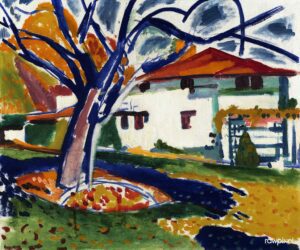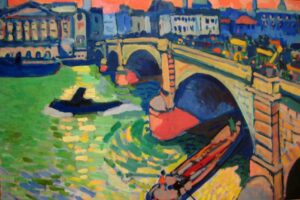Fauvism burst onto the art scene as a color revolution led by Henri Matisse and André Derain.
It’s known for its wild brushwork and vibrant colors that challenged the representational value of art.
We’ll explore how these daring artists broke from convention, using color to express emotion rather than reality.
Stay tuned as we jump into the heart of Fauvism, a movement that forever changed the trajectory of modern art.
Origins Of Fauvism
Fauvism emerged as a revolutionary art movement in the early 20th century, fundamentally disrupting the visual art scene of the time.
Historically, it burst onto the Parisian art world scene during the 1905 Salon d’Automne with Matisse’s Woman with a Hat and Derain’s London Bridge asserting their presence with striking colors and brushstrokes.
Artists before Fauvism held a reverence for depicting the natural world realistically, often bound by the muted or naturalistic color palettes of impressionism and post-impressionism.
But, Fauvists detached color from its representational purpose and used it to create an emotional impact:
- Color Freedom – Colors were no longer used to describe the natural world accurately but were instead chosen for their expressive quality.
- Expressive Brushwork – Visible brushstrokes and simplified details focused on the conveyance of artist emotion.
Even though its relatively brief flourish from 1904 to 1910, these avant-garde artists set the tone for future movements in modern art.
We can draw a clear line from the explorations of Fauvism to the advent of Cubism and subsequent modern movements.
While it may not have had the longevity of other art periods, Fauvism’s influence remains unmistakable in our collective art history.
The leaders of the Fauvism Movement, especially Matisse and Derain, challenged the status quo of the art establishment, a recurring theme in the evolution of art that we often see mirrored in the world of filmmaking.

Just as these artists broke from tradition, visionary filmmakers often harness unconventional techniques and narratives to elicit reactions from their audiences.
The parallel between the impact of Fauvism in art and the waves made by pioneering filmmakers is a testament to the power of groundbreaking creativity in all forms of visual culture.
Henri Matisse And André Derain: The Leaders Of The Movement
Henri Matisse and André Derain stand at the forefront of the Fauvism movement, forging a legacy that would reverberate through the corridors of art history.
Their collaboration began in the summer of 1905 in Collioure, a small town on the Mediterranean coast, where they experimented with bold colors and vigorous brushstrokes.
These techniques marked a decisive break from the more subdued palette and precise rendering characteristic of Impressionism and Pointillism that preceded them.
Their artworks, showcased at the 1905 Salon d’Automne, were met with both awe and critique.
Matisse’s La joie de vivre and Derain’s Charing Cross Bridge exemplified the Fauvist style with their wild brush work and bright, non-naturalistic colors.
Critics dubbed the painters ‘les Fauves’ or ‘wild beasts’, a moniker that highlighted their break from artistic convention and the visceral emotion their work evoked.
- Noteworthy characteristics that defined their work included: – Emphasis on painterly qualities and strong color over representational or realistic values – Bold, flat forms separated by dark contours – A desire to express individual experiences and emotions on canvas.
Matisse and Derain’s impact went beyond their canvases, influencing generations of artists to come.
Their focus on color as an emotional and expressive element paved the way for future movements such as Abstract Expressionism and Color Field painting.
By challenging the status quo, they underscored the potential for color and form to become the primary subjects of a painting, an idea that would have profound implications for both modern art and cinema.
Characteristics Of Fauvism
We observe that Fauvism, although short-lived, left an indelible mark on the world of art with its distinctive characteristics:
- Use of Intense Color – Fauvist artists favored a palette of extraordinarily bright, unblended colors that often defied the natural appearances of the subjects they depicted.
- Simplified Forms – Forms in Fauvist paintings are reduced to their basics, often resulting in a flat, two-dimensional appearance.
Our expertise in various art movements allows us to recognize that the rawness in Fauvist artwork comes from not just the visual tactics but also from the boldness of the brushstrokes.
Brushwork in Fauvist pieces is loose and spontaneous, providing a sense of dynamic movement within the canvas.
In exploring the influence of Fauvism on modern art and cinema, we can’t ignore the impact it had on visual storytelling.
Techniques derived from Fauvist principles help filmmakers craft enhanced mood and emotion through the strategic use of color and composition.
Expression Of Individual Experiences
Central to the Fauvist movement was the subjective expression of the artist:
- Emphasis on Painterly Qualities – Fauvists often painted directly from the tube, leading to vivid, raw brushwork.
- Bold Flat Forms – These are separated by dark contours, which sharpen the visual impact of the paintings.
As we evaluate Fauvist works like The Joy of Life by Henri Matisse or London Bridge by André Derain, we see a robust attempt at capturing emotions and sensations through the canvas.
They didn’t imitate reality but transformed it to express their feelings and reactions to the world around them.
Fauvist artists’ use of unconventional techniques and perspectives was both an assertion of personal creative freedom and a challenge to conventional aesthetic standards.

Our study of this era shows that their revolutionary work did not imitate the world but instead expressed a more profound, individual interaction with it, a concept that’s crucial not just in painting but in the cinematic narratives we weave today.
The Fauvism Manifesto
The Fauvism movement, Even though its significance, never formulated a formal manifesto.
But, the practices and statements of Fauvist artists coalesced into an unwritten set of principles.
Through their pioneering works, leaders like Henri Matisse and André Derain articulated a new visual language.
This emergent philosophy was rooted in several key tenets:
- Freedom of expression was
paramount ; artists sought to liberate color from its descriptive role and use it as an agent of emotional impact. - Traditional perspectives were abandoned for simpler forms and bold, flat planes of color, crafting compositions that favored the artist’s emotional intent over realistic depiction.
Matisse’s Woman with a Hat and Derain’s London Bridge demonstrate this newfound expressive liberty.
They showcase how color could dictate the mood of a piece, independent of the subject matter.
In these works, colors clash and harmonize in a manner that seems to anticipate the viewer’s emotional response.
In film, these principles translate into vivid color choices and composition strategies that communicate a filmmaker’s vision.
Just as Matisse and Derain disrupted the pictorial norms of their time, filmmakers employ analogous techniques to craft visually dynamic narratives.
This legacy is key to understanding the Fauvists’ impact on visual storytelling across different mediums.
Impact And Influence Of Fauvism
Proliferation Through Visual Arts
Fauvism’s radical approach rippled through visual arts like a shockwave.
It wasn’t just about the use of unbridled color – it embodied a spirit of rebellion that sparked innovations across various mediums.
Artists were no longer shackled to reality’s hues but could interpret the world through their emotive visions.
After Fauvism, movements like German Expressionism and Cubism further pushed boundaries, each a testament to Fauvism’s enduring impact.
Revolutionizing Cinematic Language
Our exploration of Fauvism’s influence inevitably turns to the silver screen.
Filmmakers delved into the Fauvist palette to enhance narrative and mood, embracing bold, expressive color schemes to elicit specific responses from the audience.
The dream sequences in What Dreams May Come and the fantastical landscapes of The Fall offer glimpses into how Fauvism continues to inform film aesthetics, transforming the viewer’s experience.
Lasting Legacy In Modern Art
- Emphasis on emotional expression – Fauvism emphasized painting feelings over replicating the physical world.
- Inspiration for abstract styles – It paved the way for abstract art, where color and form took precedence over subject matter.
Our grasp of modern art’s trajectory is incomplete without acknowledging the Fauvist movement’s significant role.

Henri Matisse and André Derain not only reshaped their own canvas but went on to inspire artists and creators for decades, underpinning the aesthetics of multiple art forms.
Their legacy endures, permeating modern artistic and cinematic expression, ensuring the lessons of Fauvism continue to inspire and provoke.
What Is Fauvism Movement In Art – Wrap Up
We’ve seen how Fauvism’s bold rebellion against traditional art forms has left an indelible mark on the creative world.
The movement’s influence extends far beyond its brief heyday, permeating the realms of modern art and cinema with a spirit of innovation and freedom.
As we reflect on the contributions of Henri Matisse, André Derain, and their contemporaries, we recognize the profound impact their fearless use of color and form has had on artists and audiences alike.
Their legacy continues to inspire and challenge us to see the world through a vibrant, emotionally charged lens.

Frequently Asked Questions
What Is Fauvism?
Fauvism is an art movement characterized by the use of vibrant colors and simplified forms.
It prioritizes emotional expression over realistic representation.
How Did Fauvism Influence The Visual Arts?
Fauvism influenced the visual arts by introducing bold color palettes and simple shapes, which paved the way for movements like German Expressionism and Cubism.
In What Way Did Fauvism Impact Cinema?
Fauvism impacted cinema by inspiring filmmakers to use expressive color schemes to enhance narrative and create mood, contributing to the development of cinematic language.
Can You Mention Key Figures In The Fauvism Movement?
Henri Matisse and André Derain are notable figures in Fauvism, known for reshaping the movement with their innovative approaches to color and form.
What Is The Lasting Legacy Of Fauvism In Modern Art?
The lasting legacy of Fauvism in modern art includes the emphasis on emotional expressiveness and its inspiration for abstract artistic styles.


